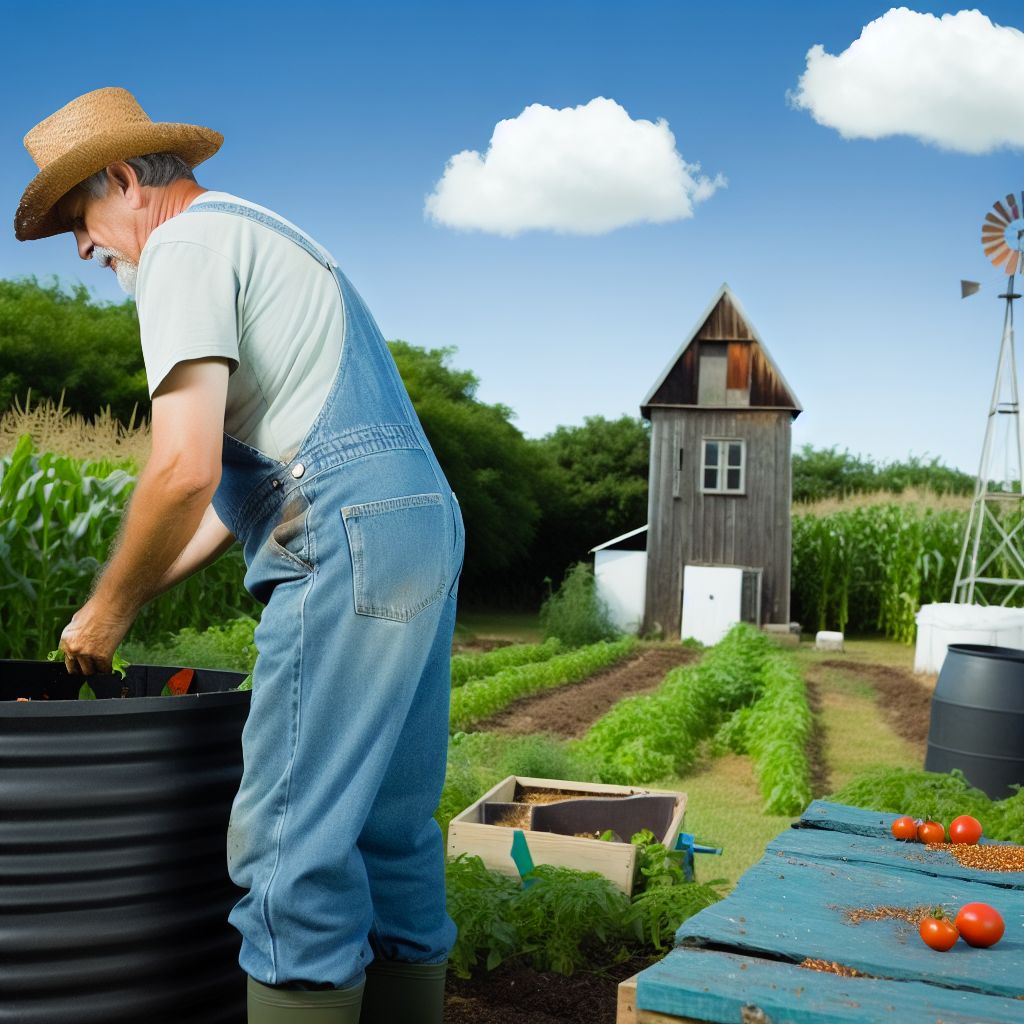Introduction to Sustainable Diversification in Farming
Understanding Sustainable Diversification
Sustainable diversification involves broadening farm operations to improve resilience.
This method minimizes risks associated with market fluctuations.
It also enhances soil health and biodiversity on farms.
Moreover, sustainable diversification supports local economies and communities.
Benefits of Sustainable Diversification
This approach allows farmers to access multiple income streams.
Consequently, it reduces reliance on a single crop or livestock type.
Farmers can also adapt to climate change impacts through diversified practices.
Additionally, diversification promotes the sustainability of farming systems.
Common Methods of Diversification
Farmers frequently adopt crop rotation to improve soil vitality.
Integrating livestock into crop production enhances nutrient cycling.
Many farmers also explore agroforestry practices for added benefits.
Community-supported agriculture initiatives connect producers directly with consumers.
Challenges in Implementing Diversification
Implementing diversification requires initial investment and resources.
Farmers may face a steep learning curve when adopting new practices.
Additionally, market access and distribution channels can complicate efforts.
Transform Your Agribusiness
Unlock your farm's potential with expert advice tailored to your needs. Get actionable steps that drive real results.
Get StartedNonetheless, these challenges can be overcome with determination and planning.
Looking Towards the Future
The future of farming lies in innovative and sustainable practices.
Farmers are encouraged to embrace diversification for long-term viability.
Collaboration among stakeholders can facilitate knowledge sharing.
Sustainable diversification stands as a crucial strategy for modern farmers.
Benefits of Diversification for Soil Health and Ecosystem Resilience
Enhancing Soil Fertility
Diversification can significantly enhance soil fertility.
Different plants contribute various nutrients to the soil.
This encourages a healthy balance of minerals and organic matter.
Diverse root structures improve soil aeration and water retention.
Promoting Biodiversity
Diversified farming systems promote greater biodiversity.
A variety of crops supports diverse insect and microbial populations.
This biodiverse environment helps in pest control naturally.
Improving Pest and Disease Resistance
Crop diversification can reduce pest and disease outbreaks.
By planting multiple species, farmers complicate pest life cycles.
This, in turn, lowers reliance on synthetic pesticides.
Moreover, diverse crops can bolster overall farm resilience.
Enhancing Water Management
Diversified crops can improve water management on farms.
Deep-rooted plants can access water from lower soil layers.
This reduces the impact of drought during dry seasons.
Additionally, varied root systems help prevent soil erosion.
Building Ecosystem Resilience
A diversified farming approach fosters ecosystem resilience.
It allows ecosystems to adapt to changes and stressors more effectively.
Diverse strategies support habitat complexity and stability.
Healthy ecosystems, in turn, provide essential services to farmers.
Showcase Your Farming Business
Publish your professional farming services profile on our blog for a one-time fee of $200 and reach a dedicated audience of farmers and agribusiness owners.
Publish Your ProfileCrop Rotation Strategies
Introduction to Crop Rotation
Crop rotation involves alternating crops in specific sequences over seasons.
This method enhances soil health and increases farm productivity.
By diversifying crops, farmers can prevent soil degradation effectively.
Benefits of Crop Rotation
- Improved soil fertility through natural replenishment.
- Reduced pest and disease risks by disrupting life cycles.
- Higher yields due to better nutrient management practices.
- Lower dependence on chemical fertilizers and pesticides.
Implementing Effective Crop Rotation
Selecting the right crops is crucial for a successful rotation.
Consider factors like soil type, climate, and market demand.
Start with legumes to enhance nitrogen levels in the soil.
Follow with grains or root vegetables to diversify nutrient uptake.
Example Crop Rotation Plans
- Legumes followed by cereals, then root crops.
- Brassicas followed by leafy greens and then potatoes.
- Sunflowers followed by oats, and then legumes.
Challenges in Crop Rotation
Farmers may face transitional hurdles when changing practices.
Market resistance can limit crop diversity choices.
Moreover, access to quality seeds for diverse crops can be challenging.
Future of Crop Rotation
Advances in technology will further support crop rotation strategies.
Sensors and data analytics can optimize crop selections.
Additionally, educating farmers on benefits encourages adoption.
Consequently, crop rotation will play a critical role in sustainable farming.
Find Out More: Creating Memorable Farm Stays To Boost Agritourism Appeal
Incorporating Livestock
Understanding Synergies
Combining livestock with crop farming creates beneficial interactions.
This method enhances nutrient cycling on the farm.
Livestock manure acts as a valuable fertilizer for crops.
Consequently, soil quality improves with this practice.
Moreover, certain animals can naturally control pests.
For instance, chickens reduce insect populations in gardens.
Diverse Livestock Options
Farmers can select various livestock to fit their needs.
Cattle provide milk and meat while enriching soil with manure.
Goats are effective in clearing brush and weeds.
Sheep contribute wool and help maintain grasslands.
Poultry offers eggs and helps with pest management.
Crop Rotation with Livestock
Incorporating livestock allows for effective crop rotation.
This strategy helps prevent soil depletion and disease buildup.
Alternating crops with livestock grazing fields enhances biodiversity.
Farmers can use cover crops that benefit both plants and animals.
Economic Benefits
Diversifying with livestock creates additional income streams.
Farmers can sell meat, dairy, and eggs alongside crops.
Furthermore, this approach reduces dependency on single crops.
Ultimately, it minimizes economic risks during market fluctuations.
Community Engagement
Incorporating livestock fosters connections with the community.
Farmers can participate in local markets to sell their products.
This practice encourages sustainable agriculture awareness.
Additionally, farm tours allow consumers to see operations firsthand.
Such initiatives enhance the local food culture.
Gain More Insights: Essential Record Keeping Practices To Ensure Farm Financial Success
Showcase Your Farming Business
Publish your professional farming services profile on our blog for a one-time fee of $200 and reach a dedicated audience of farmers and agribusiness owners.
Publish Your ProfileAgroforestry: Blending Trees with Crops for Increased Biodiversity
What is Agroforestry?
Agroforestry combines agriculture with forestry practices.
This method promotes ecological balance and enhances biodiversity.
Farmers cultivate trees along with crops to create diverse ecosystems.
Benefits of Agroforestry
This approach offers numerous benefits for contemporary farmers.
- Increased soil fertility through organic matter enhancement.
- Improved water retention and reduced erosion.
- Habitat creation for wildlife, promoting biodiversity.
Economic Advantages
Agroforestry can enhance farm profitability.
Diversifying income sources creates financial stability.
Farmers can sell both timber and crop produce.
Implementing Agroforestry Practices
Creating an agroforestry system requires careful planning.
Farmers should assess land suitability for tree and crop combinations.
Additionally, selecting trees that complement existing crops is crucial.
Case Studies of Successful Agroforestry
Many farmers have successfully implemented agroforestry.
For example, Maria Santos integrates fruit trees with coffee crops.
This practice enhances yield and provides shade for coffee plants.
Similarly, the Wilson Family Farm benefits from mixed fruit and timber production.
Challenges and Solutions
Agricultural diversification can present challenges.
For instance, managing pests can be more complex.
Farmers can overcome this by adopting integrated pest management strategies.
Education and support from extension services can aid in implementation.
The Future of Agroforestry
As climate change impacts agriculture, agroforestry offers a proactive solution.
Farmers are encouraged to adopt these sustainable practices.
Blending trees with crops holds great potential.
Gain More Insights: Ensuring Safety And Compliance In Agritourism Enterprises

Urban Agriculture: Leveraging Small Spaces for Food Production
Understanding Urban Agriculture
Urban agriculture utilizes the limited space in cities effectively.
It transforms backyards, rooftops, and community gardens into productive farms.
This practice enhances food security in densely populated areas.
Additionally, urban agriculture reduces the carbon footprint of food transportation.
By cultivating food locally, neighborhoods can enjoy fresher produce.
Choosing Appropriate Crops
Selecting the right crops is crucial for urban farming success.
Fast-growing vegetables, like lettuce and radishes, thrive in small spaces.
Herbs are also excellent options for urban growers.
A variety of greens maximizes yield while minimizing space usage.
Consider vertical gardening techniques to expand planting options.
Implementing Innovative Techniques
Vertical gardening allows farmers to grow upwards rather than outwards.
This method takes advantage of limited horizontal space.
Container gardening is another adaptable technique.
It enables urban dwellers to move plants and optimize sunlight exposure.
Hydroponics and aquaponics showcase cutting-edge solutions for urban agriculture.
Community Engagement and Education
Community involvement is vital for successful urban farms.
Workshops can educate residents about sustainable practices.
Collaboration among neighbors fosters a sense of ownership.
Showcase Your Farming Business
Publish your professional farming services profile on our blog for a one-time fee of $200 and reach a dedicated audience of farmers and agribusiness owners.
Publish Your ProfileFurthermore, community-supported agriculture (CSA) models enhance participation.
Locally-grown food brings neighbors together, building lasting connections.
Addressing Challenges in Urban Farming
Urban farming faces unique challenges, such as limited land availability.
Access to adequate sunlight can also be a concern.
Soil contamination requires careful consideration in urban settings.
Farmers should conduct soil tests before planting.
Implementing raised beds can help mitigate soil issues.
Benefits of Urban Agriculture
Urban farms contribute to local economies and job creation.
They improve access to fresh produce in food deserts.
Environmental benefits include reduced stormwater runoff.
Moreover, urban farming promotes green spaces and biodiversity.
Ultimately, urban agriculture enhances community resilience.
Find Out More: Diversifying Farm Income Through Effective Agritourism Strategies
Community Supported Agriculture (CSA): Building Local Farm Networks
Understanding Community Supported Agriculture
Community Supported Agriculture allows consumers to buy shares of a farm’s harvest.
This model supports local farmers while providing fresh produce to communities.
Members pay upfront for a season’s worth of food.
In return, they receive regular deliveries of seasonal goods.
This system creates a direct connection between farmers and consumers.
Benefits of CSA Programs
CSA programs offer multiple benefits to both farmers and consumers.
First, they provide farmers with financial security early in the season.
Farmers can plan their crop production with guaranteed income.
Additionally, CSAs reduce marketing and distribution costs.
Consumers enjoy fresh, local, and organic produce.
Thus, they can support local economies and sustainability efforts.
Building Local Networks
Establishing a CSA requires building strong local networks.
Farmers should connect with local businesses and community organizations.
Sharing resources helps build a supportive environment for agriculture.
Local farms can collaborate to host events, workshops, and farm tours.
This interaction fosters community interest and investment in farming.
Marketing Strategies for CSAs
Effective marketing is essential for CSA success.
Farmers can utilize social media to reach potential members.
By sharing engaging content, they can showcase their offerings.
Additionally, farmers can create newsletters to keep members informed.
Regular communication builds trust and keeps customers engaged.
Challenges and Solutions in CSA Implementation
Despite their benefits, CSAs face several challenges.
Some consumers may hesitate to commit to a subscription model.
To address this, farmers can offer trial shares or flexible options.
Additionally, weather and crop failures can impact production.
Farmers should diversify crops to mitigate risk and ensure variety.
Case Studies: Successful CSA Models
Many farms have successfully implemented CSA programs.
Showcase Your Farming Business
Publish your professional farming services profile on our blog for a one-time fee of $200 and reach a dedicated audience of farmers and agribusiness owners.
Publish Your ProfileSunny Fields Farm in Colorado has grown its membership rapidly.
They offer diverse produce and educational workshops for members.
Bright Harvest Farms in Oregon has teamed with local chefs.
They provide exclusive recipes and meals for their CSA members.
Future Trends in Community Supported Agriculture
The future of CSAs looks promising as more people seek local food sources.
Technology will continue to play a key role in connecting farmers with consumers.
Online ordering and home delivery options will expand access.
Furthermore, sustainability practices will enhance community engagement.
This shift ensures a focus on health, environment, and local economies.
Technology and Innovation in Diversification
Integrating Technology in Farming
Farmers increasingly rely on technology to drive diversification.
This integration leads to improved efficiency in operations.
For instance, precision farming enhances resource use.
Farmers benefit from data-driven methods to monitor crops effectively.
Moreover, drones provide aerial views of the fields.
This technology facilitates timely interventions when needed.
Utilizing Data for Improved Decision-Making
Data analytics empowers farmers to make informed choices.
With access to weather forecasts, farmers can plan better.
Soil health metrics guide crop selection for optimal yields.
Farmers can analyze sales trends to diversify product offerings.
Implementing a data management system can streamline operations.
Examples of Successful Technology Integration
Carl Green, a soybean farmer, uses precision agriculture tools.
He monitors soil moisture levels using IoT devices.
This technology has led to a 20% increase in yield.
Similarly, Emily Johnson employs data analytics for crop rotation.
Her approach reduces input costs while maximizing outputs.
Challenges and Considerations
Despite its advantages, technology adoption faces challenges.
High initial costs can deter some farmers from upgrading.
Additionally, technology literacy varies among farmers.
Therefore, training programs become vital to support these transitions.
Farming cooperatives can provide shared resources and knowledge.
By tackling these challenges, farmers can fully leverage technology.
Additional Resources
Plant biodiversity promotes sustainable agriculture directly and via …




